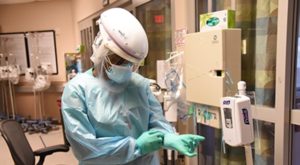
A staff member of the Michael E. DeBakey VAMC in Houston finishes donning her personal protective equipment. Legislators believe federal health facilities should led the way in urging the use of American-made equipment. Photo from July 28, 2020, VAntage Point blog.
WASHINGTON — As the pandemic numbers rose last spring, the VA discovered what hospital systems across the country were learning—that the usual supply chains for personal protective equipment (PPE) could not handle the demand, and the gray market was rife with price-gouging and low-quality products.
The result was a monthslong shortage of PPE that required VA hospitals to implement scarcity protocols such as the reuse of masks and limiting mask distribution to high-risk employees. While VA denied that such protocols put workers at risk, workers at VA facilities across the country spoke out publicly about how the lack of PPE made them feel unsafe.
This tension has lingered throughout the pandemic, rippling upward to include legislators and veterans’ advocacy groups, who have struggled to get VA leaders to admit that hospitals do not have enough PPE.
Now, Congress and manufacturers are examining how to prevent strangled supply chains of PPE and other medical equipment in the future. One solution coming from multiple corners is dependent on large federal agencies like VA and DoD that have a stake in healthcare: Make it mandatory that these agencies buy American.
At a Senate Commerce Committee hearing last month, legislators spoke with representatives from a number of U.S. PPE manufacturers. During the hearing, China was identified again and again as a main problem in shoring up the American medical equipment supply chain. China’s lower quality control standards resulted in inferior products, manufacturers argued. And, because their manufacturing costs are considerably lower, buyers looking for the cheapest source are frequently drawn to Chinese companies.
“I would be remiss if I did not address the unique security and economic consequences if America does not fortify and strengthen its national supply chain particularly when it relates to the national stockpile of PPE,” declared Sen. Jerry Moran (R-KS.). “The threat from China to our manufacturing sector is real.”
According to Moran, the United States imported $20.7 billion in medical equipment and pharmaceuticals from China in 2019. That number, he said, has likely risen as demand for products rose sharply during the pandemic.
Manufacturers echoed his concerns.
“The problem was twofold. The hospitals wanted gowns fast, and they wanted them cheap. To meet the aggressive supply schedule, I had to invest in new machinery and hire more employees,” testified Neil Gilman, president of the Connecticut-based Gilman Gear. During the height of the pandemic, Gilman Gear retooled one of its factories to go from making sporting equipment and team uniforms to manufacturing surgical and isolation gowns.
“We went from making 200 gowns a week to more than 12,000 gowns per week,” Gilman explained. “Pricing was an even more difficult hurdle. The hospitals were reluctant to pay more than the price they paid for the product exported from China. I couldn’t match that price unless I moved my factory to China. My gowns are 100% American-made. I’m at a competitive disadvantage. My labor costs are higher. My material costs are higher. I’m able to mitigate some of the cost disparity with technology. But, at the end of the day, my American made gown is two to three times more expensive than those made in China. However, my American-made gown is a higher quality and meets a higher level of protection. But in the PPE market an Isolation gown is considered a commodity item, and buyers in the medical community are just looking for the cheapest price.”
Buy American for PPE?
One of the solutions suggested by Gilman and other manufacturers is for the United States to implement a “Buy American” preference across all federal agencies. Whenever possible, agencies like VA and DoD would buy from American companies, even if they could find a lower price overseas.
That recommendation also appeared in a 2019 report from the U.S.-China Economic Security Review Commission, a congressional commission tasked with monitoring national security and trade issues with China.
“We can harness federal procurement policy through Medicare, Medicaid, VA and DoD to buy American products,” commissionmember Michael Wessel told legislators. “To [leverage] our existing authorities to bring these supply chains back to the U.S.”
The federal government spends billions annually on medical equipment, supplies and pharmaceuticals, and spending on PPE has grown significantly. During the height of the pandemic, VA went from spending $10 million weekly on PPE to $100 million weekly.
According to the commission, the dangers of making China the well-spring of the medical supply chain is not just an economic issue but a national security problem.
“In putting the spotlight on supply chains for medical equipment, the COVID-19 crisis taught the American public not only about our loss of productive capacity, but also China’s policies that contributed to that problem and its ability to control supplies and use them as foreign policy leverage,” Wessel explained.
There also is the fear that lower quality control, which can put end-users of medical supplies at risk.
“The Chinese government’s failure to conduct adequate inspections of manufacturing facilities and lack of quality control all became nightly news stories,” Wessel declared. “Masks sold as meeting the N95 standard were often found to be almost ineffective—possibly less effective than simply using a bandana as a face mask.”
In addition to strengthening American manufacturers, the federal government should also use what authority it has to ensure the quality of Chinese-made products.
“The FDA should be allowed to go into every facility in China that is sending its products to the U.S. And we need to make sure that happens, or its products are unable to come here,” Wessel told the committee. “We also have to disclose where essential drugs and products are coming from. … So citizens and officials know where the supply chains are linked, where the products are coming from and how we can best prepare and protect.”

